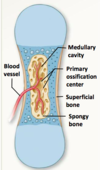Ch. 6-5 Bone Growth Flashcards
(31 cards)
The deposition of calcium salts - occurs during ossification, but also in other tissues
calcification
- Bone replaces existing cartilage
- Most originate as hyaline cartilage
Endochondral ossification
bone develops directly from mesenchyme or fibrous connective tissue
intramemranous ossification
- Cartilage enlarges (outer appositional and inner interstitial growth)
- chondrocytes near the center of the shaft increase in size
- matrix is reduced to a series of small struts that begin to calcify
- enlarged chondrocytes die and disintegrate

First step of endochondral ossification
- Blood vessels grow around edges of cartilage
- cells of perichondrium convert to osteoblasts
- shaft of cartilage ensheathed in superficial bone layer

2nd step of endochondral ossification
- Blood vessels penetrate the cartilage and invade the central region
- Fibroblasts migrating with the blood vessels differentiate into osteoblasts and produce spongy bone at the primary ossification center
- Bone formation spreads towards both ends

3rd step of endochondral ossification
- Remodeling occurs as growth continues, creating medullary cavity
- Osseous tissue of shaft becomes thicker
- Cartilage near each epiphyses replaced with bone
- Growth to increase length & diameter (2 distinct processes)

4th step of endochondral ossification
Capillaries and osteoblasts migrate into epiphyses, creating secondary ossification centers

5th step of endochondral ossification
- Epiphyses filled with spongy bone
- A thin cap of articular cartilage remains exposed to the joint cavity
- epiphyseal cartilage (epiphyseal plate) separates epiphysis from diaphysis

When osteoblasts ‘catch up’ with chondrocyte production of epiphyseal cartilage, which ultimately disappears. The former location of this cartilage forms a ____ ___ detectable in x-rays
epiphyseal line
Appositional Growth
(Endochondral ossification)
- Cells of the inner layer of periosteum differentiate into osteoblasts and deposit superficial layers of bone matrix
- Osteoblasts become surrounded by matrix and differentiate into osteocytes
- Appositional growth adds a series of layers that form circumferential lamellae.
osteoblasts differentiate within a mesenchymal or fibrous connective tissue.
Intramembraneous ossification
(dermal ossification)
Flat bones of the skull
Mandible (lower jaw)
Clavicle
Dermal bones that result from ossification that occurs in the deeper layers of the dermis (dermal ossification)
- Mesenchymal cells cluster (ossification center) and start to secrete organic components of matrix.
- As calcification occurs, mesenchymal cells differentiate into osteoblasts
- Developing bone grows outward in smalls truts (spicules)
- Trapped osteoblasts differentiate into osteocytes
First step of intramembranous ossification
Blood vessels begin to grown into ossification areas; spicules meet and fuse toegher.
2nd step of intramembraneous ossification
- Remodeling of trapped blood vessels around spongy bone produces osteons of compact bone.
- Connective tissue around the bone becomes organized into fibrous layer of the periosteum
- Osteoblasts closest to surface become less active, but remain in inner layer
3rd (last) step of intramembraneous ossification
The blood vessels that supply the diaphysis invade the cartilage model as endochondral ossifcation begins.
The Nutrient Artery and Vein
(Most bones have only one)
The entry point for the nutrient artery and vein in the diaphysis
nutrient foramina
Supply blood to the inner (diaphyseal) surface of each epiphyseal cartilage, where that cartilage is being replaced by bone
Metaphyseal vessels
Blood vessels of periosteum provide blood to the superficial osteons of the shaft. During endchondral bone formation, branches of these also enter epiphyses to provide blood to secondary ossification centers
periosteal vessels
The hormone ______ is synthesized in the ______ from the steroid _______, and is essential for normal calcium and phosphate ion absorption in the digestive tract.
- calcitriol
- kidneys
- cholecalciferol (Vitamin D3)
Vitamins
______ is required for key enzymatic reactions in collagen snythesis, and stimulates osteoblast differentiation
______ stimulates osteoblast activity, essential in children
________ and ________ are required for the synthesis of proteins in normal bone
- Vitamin C
- Vitamin A
- Vitamins K and B12
____ _______ is produced by the ______ gland stimulates protein synthesis and cell growth
Growth Hormone, pituitary
_______ is produced by the _____ gland. It stimulates cell metabolism and increses the rate of osteoblast activity
thyroxine; thyroid


